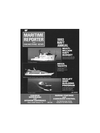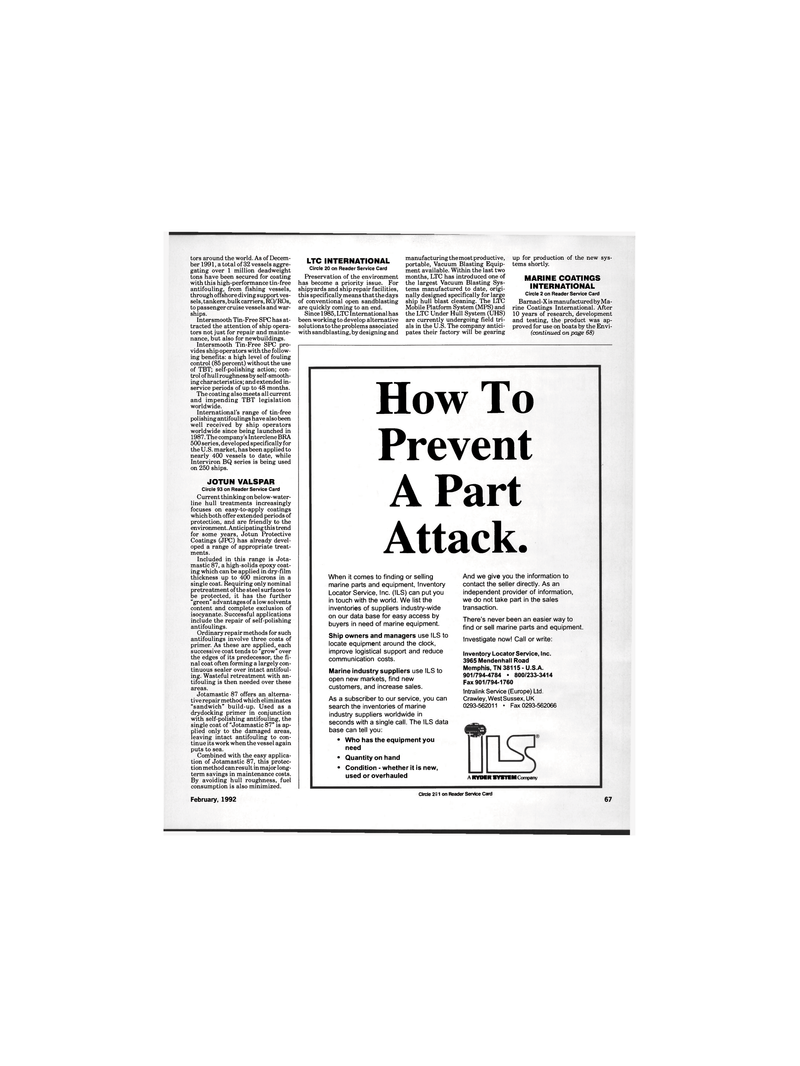
Page 67: of Maritime Reporter Magazine (February 1992)
Read this page in Pdf, Flash or Html5 edition of February 1992 Maritime Reporter Magazine
tors around the world. As of Decem- ber 1991, a total of 32 vessels aggre- gating over 1 million deadweight tons have been secured for coating with this high-performance tin-free antifouling, from fishing vessels, through offshore diving support ves- sels, tankers, bulk carriers, RO/ROs, to passenger cruise vessels and war- ships.
Intersmooth Tin-Free SPC has at- tracted the attention of ship opera- tors not just for repair and mainte- nance, but also for newbuildings.
Intersmooth Tin-Free SPC pro- vides ship operators with the follow- ing benefits: a high level of fouling control (85 percent) without the use of TBT; self-polishing action; con- trol of hull roughness by self-smooth- ing characteristics; and extended in- service periods of up to 48 months.
The coating also meets all current and impending TBT legislation worldwide.
International's range of tin-free polishing antifoulings have also been well received by ship operators worldwide since being launched in 1987. The company's Interclene BRA 500 series, developed specifically for the U.S. market, has been applied to nearly 400 vessels to date, while
Interviron BQ series is being used on 250 ships.
JOTUN VALSPAR
Circle 93 on Reader Service Card
Current thinking on below-water- line hull treatments increasingly focuses on easy-to-apply coatings which both offer extended periods of protection, and are friendly to the environment. Anticipating thi s trend for some years, Jotun Protective
Coatings (JPC) has already devel- oped a range of appropriate treat- ments.
Included in this range is Jota- mastic 87, a high-solids epoxy coat- ing which can be applied in dry-film thickness up to 400 microns in a single coat. Requiring only nominal pretreatment of the steel surfaces to be protected, it has the further "green" advantages of a low solvents content and complete exclusion of isocyanate. Successful applications include the repair of self-polishing antifoulings.
Ordinary repair methods for such antifoulings involve three coats of primer. As these are applied, each successive coat tends to "grow" over the edges of its predecessor, the fi- nal coat often forming a largely con- tinuous sealer over intact antifoul- ing. Wasteful retreatment with an- tifouling is then needed over these areas.
Jotamastic 87 offers an alterna- tive repair method which eliminates "sandwich" build-up. Used as a dry docking primer in conjunction with self-polishing antifouling, the single coat of "Jotamastic 87" is ap- plied only to the damaged areas, leaving intact antifouling to con- tinue its work when the vessel again puts to sea.
Combined with the easy applica- tion of Jotamastic 87, this protec- tion method can result in maj or long- term savings in maintenance costs.
By avoiding hull roughness, fuel consumption is also minimized.
February, 1992
LTC INTERNATIONAL
Circle 20 on Reader Service Card
Preservation of the environment has become a priority issue. For shipyards and ship repair facilities, this specifically means that the days of conventional open sandblasting are quickly coming to an end.
Since 1985, LTC International has been working to develop alternative solutions to the problems associated with sandblasting, by designing and manufacturing the most productive, portable, Vacuum Blasting Equip- ment available. Within the last two months, LTC has introduced one of the largest Vacuum Blasting Sys- tems manufactured to date, origi- nally designed specifically for large ship hull blast cleaning. The LTC
Mobile Platform System (MPS) and the LTC Under Hull System (UHS) are currently undergoing field tri- als in the U.S. The company antici- pates their factory will be gearing up for production of the new sys- tems shortly.
MARINE COATINGS
INTERNATIONAL
Circle 2 on Reader Service Card
Barnacl-X is manufactured by Ma- rine Coatings International. After 10 years of research, development and testing, the product was ap- proved for use on boats by the Envi-
Ccontinued on page 68) 67
How To
Prevent
APart
Attack.
When it comes to finding or selling marine parts and equipment, Inventory
Locator Service, Inc. (ILS) can put you in touch with the world. We list the inventories of suppliers industry-wide on our data base for easy access by buyers in need of marine equipment.
Ship owners and managers use ILS to locate equipment around the clock, improve logistical support and reduce communication costs.
Marine industry suppliers use ILS to open new markets, find new customers, and increase sales.
As a subscriber to our service, you can search the inventories of marine industry suppliers worldwide in seconds with a single call. The ILS data base can tell you: • Who has the equipment you need • Quantity on hand • Condition - whether it is new, used or overhauled
And we give you the information to contact the seller directly. As an independent provider of information, we do not take part in the sales transaction.
There's never been an easier way to find or sell marine parts and equipment.
Investigate now! Call or write:
Inventory Locator Service, Inc. 3965 Mendenhall Road
Memphis, TN 38115 - U.S.A. 901/794-4784 • 800/233-3414
Fax 901/794-1760
Intralink Service (Europe) Ltd.
Crawley, West Sussex, UK 0293-562011 • Fax 0293-562066
A RYDER SYSTEM Company
Circle 251 on Reader Service Card

 66
66

 68
68
